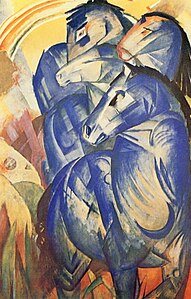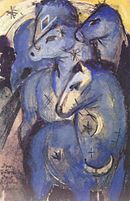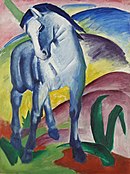The tower of the blue horses

|
| The tower of the blue horses |
|---|
| Franz Marc , 1913 |
| Oil on canvas |
| 200 × 130 cm |
| lost since 1945 |
The Tower of the Blue Horses is the title of a 1913 painting by the expressionist painter Franz Marc, who died in World War I in 1916. It is one of his most famous works and has been lost since the end of World War II in 1945. The last known owner was Hermann Göring , who acquired the painting for his art collection after it was removed from the “ Degenerate Art ” exhibition in Munich in 1937.
description
The large-format painting with the dimensions 200 × 130 cm can only be viewed in reproductions, as it has been lost since the end of the Second World War. The picture is dominated by a group of four horses in shades of blue, one on top of the other, with their heads turned to the left, on mighty, almost life-size bodies. Your croups form the center of the picture. At the left edge of the picture is an abstract rocky landscape in yellow, brown and red tones, which is vaulted by an orange-colored striped rainbow on a yellow background. The rainbow and the crescent moon as well as the crosses on the body of the first horse in the foreground may represent Marc's intention to represent the unity of cosmos and nature.
History of the painting
Created in 1913
The tower of the blue horses comes from the beginning of the abstract painting style of the artist and was created in his place of residence in Sindelsdorf . Marc had been dealing with the subject of "horses" for a long time. An example is his well-known painting Blue Horse I from 1911, which shows a foal painted in blue with its head tilted to one side.
In his color theory, the color blue determines the male gender: Franz Marc formulated it in a letter to Macke on December 12, 1910:
- “Blue is the male principle, bitter and spiritual. Yellow is the feminine principle, gentle, cheerful and sensual. Red is the matter, brutal and heavy and always the color that must be fought and overcome by the other two! Do you mix B. the serious, spiritual blue with red, then you increase the blue to unbearable mourning, and the reconciling yellow, the complementary color to violet, becomes indispensable. [...] If you mix red and yellow to orange, you give the passive and feminine yellow a mega-fairy, sensual power that the cool, spiritual blue becomes indispensable again, the man, and indeed the blue immediately and automatically stands next to orange, the colors love each other. Blue and orange, a thoroughly festive sound. But if you mix blue and yellow to green, you awaken red, matter, the earth, to life. "

Marc used the color yellow as a female principle, for example, in his work The Yellow Cow from 1911; it was shown at the first exhibition of the Blue Rider , which ran from December 18, 1911 to January 1, 1912 in Munich.
A postcard from 1912 shows a drawing, executed in ink and ink, which he sent in 1912 to his friend, poet Else Lasker-Schüler . Next to a horse and a rider are the words: "The blue rider presents your highness his blue horse ..." It was the first of 28 card greetings that he sent to the poet. A New Year's greeting to Lasker-Schüler in 1913 in the 14 × 9 cm format was the first colored draft on paper for the painting. He had developed it from a pencil sketch he had made shortly beforehand and insigned the crescents and stars with which the poet had sealed her letter of thanks. According to Peter-Klaus Schuster , the world of Marc is "adorned with all the set pieces of otherworldly, unearthly beauty that the poet also makes use of". Marc adopted these details in his painting of the same name.
The picture was taken in the first few months of the new year, the friend Wassily Kandinsky saw the picture in Sindelsdorf on the easel in the attic of the farmhouse, where Marc also had his studio in winter.
Franz Marc was involved in the design of Herwarth Walden's First German Autumn Salon , which took place in Berlin from September 18 to December 1, 1913. He showed paintings by international avant-garde , which led to violent reactions in the Berlin public. Marc added seven new pictures to the exhibition, including Animal Fates and The Tower of the Blue Horses , which was numbered 272 in the exhibition catalog.
Exhibition and whereabouts
The Tower of the Blue Horses was acquired in July 1919 by Ludwig Justi , the director of the Nationalgalerie Berlin , on the advice of August Gaul for 20,000 Reichsmarks from Marc's widow Maria Marc and hung in a prominent place in the Kronprinzenpalais . The visitors to the Olympic Games in 1936 could still see it, in 1937 it was removed because the National Socialists were now defaming Franz Marc as a “ degenerate artist ” . They confiscated more than 130 of his works from German collections and museums, including all of Marc's pictures in the Nationalgalerie. Six of them were exhibited from July 19, 1937 in the exhibition "Degenerate Art" in the Archaeological Institute of the Hofgartenarkaden .
The tower of the blue horses with the directory number 14126, like the other works of Marc, was removed from the exhibition after the German Officers' Association protested at the Reich Chamber of Fine Arts that pictures of a front soldier who died in the First World War near Verdun had fallen, would be shown in the exhibition. The Frankfurter Zeitung registered on 14 November 1937 laconic the removal of the "Blue Horses". Since the works considered “degenerate” were to be sold in Switzerland to bring foreign currency, they were temporarily stored in Castle Niederschönhausen . In the corresponding list, the tower of the blue horses is listed and valued at 80,000 Reichsmarks. Hermann Göring selected 13 paintings to include for his collection, including by Marc Hirsche im Walde and The Tower of the Blue Horses , which was now valued at 20,000 Reichsmarks . Göring is said to have paid 165,000 Reichsmarks for all the pictures together.
The art historian and former Reichskunstwart Edwin Redslob and the Berlin journalist Joachim Nawrocki claim to have seen the painting in Berlin after the end of the war . According to Redslob, it was in the " Haus am Waldsee " (formerly the seat of the Reichsfilmkammer ) in Zehlendorf around 1945 , while Nawrocki saw it around 1948/49 in a youth home right next door. He reported that the painting was damaged by cuts. The youth home was the former home of Wolf-Heinrich von Helldorff , former police chief of Berlin , who was executed as a resistance fighter in 1944.
In 2001 there were suspicions that the painting was in a Zurich bank safe, but this could not be proven. The Tower of the Blue Horses is also currently missing, and it is unknown whether it was destroyed or taken as a looted art .
Color reproduction
The painting has come down to us in a variety of different color images, which were distributed as art prints and postcards by Munich companies such as Bruckmann or Hanfstaengl before 1933 and after the Second World War and the disappearance of the original . Due to its importance, it was often depicted in illustrated books, monographs and exhibition catalogs, usually referring to the provenance of the oil painting. A color template from the Artothek picture archive was used in the 2004 catalog raisonné .
Literature, exhibition and film
-
Missing. The tower of the blue horses. Contemporary artists in search of a lost masterpiece , exhibition at Haus am Waldsee , Berlin, March 3 to June 5, 2017; at the same time in the State Graphic Collection in Munich .
- Katja Blomberg and Michael Hering (eds.): Missed, The Tower of the Blue Horses by Franz Marc, contemporary artist in search of a lost masterpiece , Verlag der Buchhandlung Walther König, Cologne 2017, ISBN 978-3-96098-095-7 .
- Uwe Fleckner: Attack on the Avant-Garde: Art and Art Politics in National Socialism. Akademie Verlag, Berlin 2007, ISBN 978-3-05-004062-2 .
- Klaus Lankheit : The tower of the blue horses. Reclam, Stuttgart 1961.
- Susanna Partsch : Marc . 9th edition. Taschen Verlag, Cologne 2009, ISBN 978-3-8228-5585-0 .
- 1989: History of a picture: The tower of the blue horses, Franz Marc, 1913 , 21 min., DEFA
- Annegret Hoberg , Isabelle Jansen: Franz Marc, catalog raisonné, vol. I, paintings . Beck, Munich 2004, ISBN 3-406-51139-2 , # 211, p. 246.
- Else Lasker-Schüler, Franz Marc: My dear, wonderful blue rider: private correspondence . Edited by Ulrike Marquardt. Artemis & Winkler, Düsseldorf 1998, ISBN 3-538-06820-8
Web links
- Stefan Koldehoff : On the hunt for Göring's lost treasure. In: Welt am Sonntag , July 24, 2010.
- Mario-Andreas von Lüttichau : Horses, please report! In: art - Das Kunstmagazin , Issue 5, 2001
Individual evidence
- ↑ Susanna Partsch: Marc , p. 46 f
- ^ Letter from Marc to Macke of December 12, 1910 , zeno.org, quoted from: Franz Marc, August Macke: Briefwechsel . DuMont, Cologne 1964., pp. 27–30, accessed on March 23, 2011
- ^ Ricarda Dick: Else Lasker-Schüler as an artist. In: Else Lasker-Schüler. Die Bilder , exhibition catalog, edited by Ricarda Dick on behalf of the Jewish Museum Frankfurt am Main, Jüdischer Verlag im Suhrkamp Verlag, Berlin 2010, ISBN 978-3-633-54246-8 , pp. 117–158, here p. 136
- ↑ Franz Marc - Else Lasker-Schüler, The blue rider presents your highness his blue horse, cards and letters . Edited and commented by Peter-Klaus Schuster. Prestel, Munich 1987, ISBN 3-7913-0825-4 , p. 119
- ↑ Susanna Partsch: Marc , p. 66 f
- ^ Klaus Lankheit: Franz Marc in the judgment of his time . Piper, Munich 1989, ISBN 3-492-10986-1 , p. 50
- ↑ Klaus Lankheit: The tower of the blue horses . Reclam, Stuttgart 1961, p. 5
- ↑ Beate Ofczarek, Stefan Frey: Chronology of a friendship . In: Michael Baumgartner, Cathrin Klingsöhr-Leroy, Katja Schneider (Eds.), P. 222
- ↑ Quoted from Weblink art - Das Kunstmagazin
- ↑ Are the blue horses returning soon? , berliner-kurier.de, April 3, 2001, accessed December 15, 2013
- ↑ Joachim Nawrocki: The Blue Horses: Göring's Last Prisoners In: Die Welt , March 30, 2001, accessed on August 9, 2011
- ↑ See also web link Stefan Koldehoff
- ↑ The Tower of the Blue Horses. In: Berliner Zeitung. March 31, 2001, accessed August 10, 2011
- ↑ See also web link Stefan Koldehoff
- ^ Annegret Hoberg, Isabelle Jansen: Franz Marc catalog raisonné, vol. I, paintings. P. 19, P. 27 Note 32. For Artothek, Weilheim see web link
